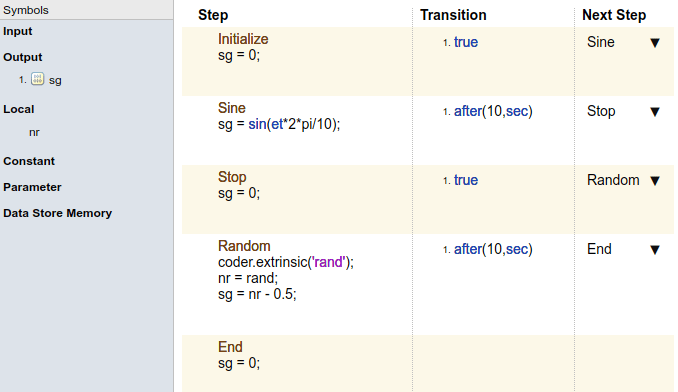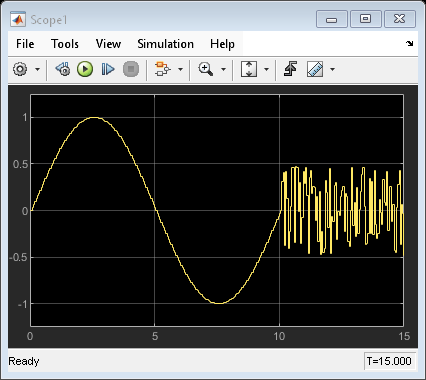Generate Test Signals
In the Test Sequence block, you can generate signals to use for testing. First, define an output data symbol using the Data Symbols pane, and then use that output name with a signal generation function in a test step. For information on adding symbols, see Manage Input, Output, and Data Objects. For an example that shows how to implement signal functions in a Test Sequence block, see Sinusoidal and Random Number Functions in Test Sequences
Signal Generation Functions
The following table lists common functions you can use in the Test Sequence block to
create test signals, random number values, and natural exponents. It also describes the
latch function, which saves and returns a specific value evaluated
within a test sequence step. For more information about each function, click its name in the
first column.
Some signal generation functions use the temporal operator et, which is
the elapsed time of the test step in seconds. For additional operators related to
et that you can use in test sequence steps, see Temporal Operators.
Note
Scaling, rounding, and other approximations of argument values can affect function outputs.
| Function | Syntax | Description | Example |
|---|---|---|---|
sin | sin(x) | Returns the sine of | A sine wave with a period of 10 sec: sin(et*2*pi/10) |
cos | cos(x) | Returns the cosine of | A cosine wave with a period of 10 sec: cos(et*2*pi/10) |
| square | square(x) | Square wave output with a period of Within
the interval
| Output a square wave with a period of square(et/10) |
| sawtooth | sawtooth(x) | Sawtooth wave output with a period of Within
the interval
| Output a sawtooth wave with a period of sawtooth(et/10) |
| triangle | triangle(x) | Triangle wave output with a period of Within
the interval
| Output a triangle wave with a period of triangle(et/10) |
| ramp | ramp(x) | Ramp signal of slope
| Ramp one unit for every 5 seconds of test step elapsed time: ramp(et/5) |
| heaviside | heaviside(x) | Heaviside step signal, returning
| Output a heaviside signal after heaviside(et-5) |
exp | exp(x) | Returns the natural exponential function, . | An exponential signal progressing at one tenth of the test step elapsed time: exp(et/10) |
rand | rand | Uniformly distributed pseudorandom values | Generate new random values for each simulation by declaring
coder.extrinsic('rand')
nr = rand
sg = a + (b-a)*nr |
randn | randn | Normally distributed pseudorandom values | Generate new random values for each simulation by declaring
coder.extrinsic('randn')
nr = randn
sg = nr*2 |
| latch | latch(x) | Saves the value of
| Latch b = latch(torque) |
Sinusoidal and Random Number Functions in Test Sequences
This example shows how to produce a sine and a random number test signal in a Test Sequence block.
If you recreate this test sequence, before running it, set the nr symbol size and type. Hover over the nr symbol and click its Edit icon to open the Data Inspector. Set the Size to 1 and the Type to double.
The step Sine outputs a sine wave with a period of 10 seconds, specified by the argument et*2*pi/10. The step Random outputs a random number in the interval -0.5 to 0.5.

The test sequence produces signal sg.

See Also
Test Sequence | Test Sequence and Assessment Syntax
